Influence of Safety Inspections on Workplace Accidents: Report
VerifiedAdded on 2021/04/17
|54
|14410
|98
Report
AI Summary
This report investigates the impact of safety inspections on workplace health and safety, focusing on a case study conducted in a Singapore workplace. The research examines the effects of both routine and random safety inspections on accident rates and the reduction of health hazards. The study involved surveys of supervisors, managers, and workers, along with detailed inspections over a period of time. The findings, presented with charts and diagrams, highlight the influence of inspection frequency and other contributing factors such as management commitment and training effectiveness. The report concludes with recommendations for improving workplace safety through strategic inspection practices and emphasizes the importance of comprehensive safety programs to minimize accidents and health risks. The study also reviews literature on occupational accidents and the implementation of work safety programs.
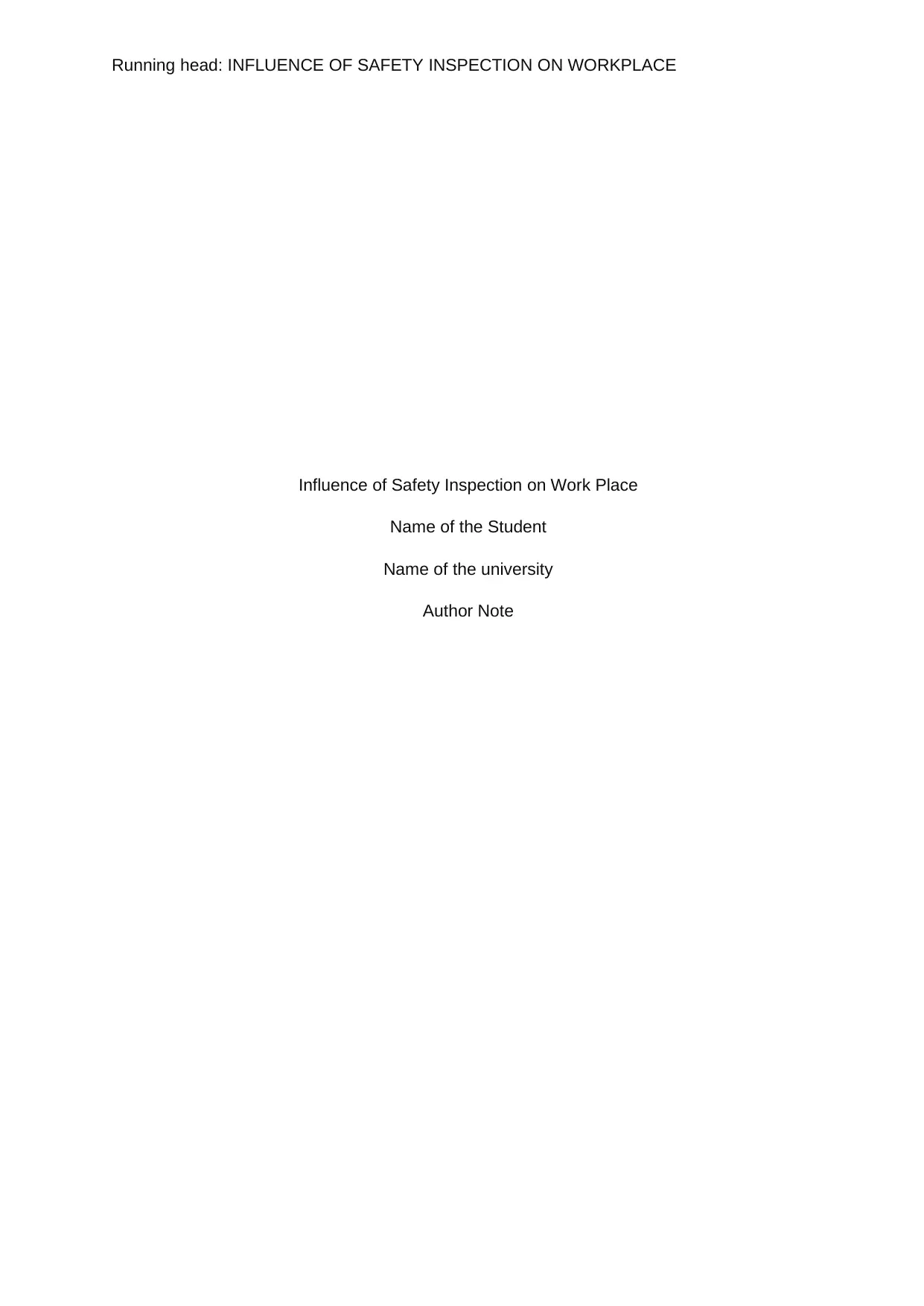
Running head: INFLUENCE OF SAFETY INSPECTION ON WORKPLACE
Influence of Safety Inspection on Work Place
Name of the Student
Name of the university
Author Note
Influence of Safety Inspection on Work Place
Name of the Student
Name of the university
Author Note
Paraphrase This Document
Need a fresh take? Get an instant paraphrase of this document with our AI Paraphraser
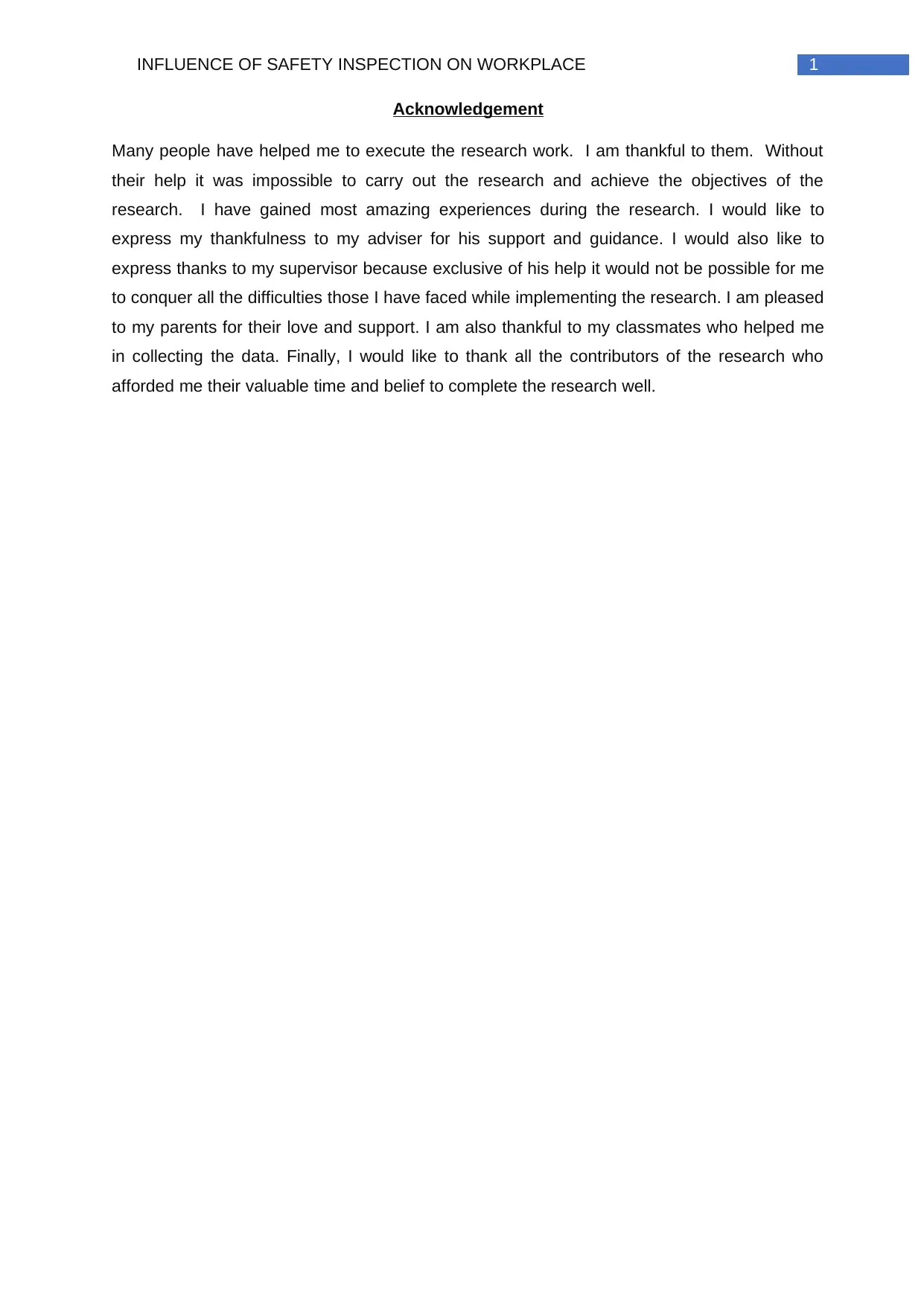
1INFLUENCE OF SAFETY INSPECTION ON WORKPLACE
Acknowledgement
Many people have helped me to execute the research work. I am thankful to them. Without
their help it was impossible to carry out the research and achieve the objectives of the
research. I have gained most amazing experiences during the research. I would like to
express my thankfulness to my adviser for his support and guidance. I would also like to
express thanks to my supervisor because exclusive of his help it would not be possible for me
to conquer all the difficulties those I have faced while implementing the research. I am pleased
to my parents for their love and support. I am also thankful to my classmates who helped me
in collecting the data. Finally, I would like to thank all the contributors of the research who
afforded me their valuable time and belief to complete the research well.
Acknowledgement
Many people have helped me to execute the research work. I am thankful to them. Without
their help it was impossible to carry out the research and achieve the objectives of the
research. I have gained most amazing experiences during the research. I would like to
express my thankfulness to my adviser for his support and guidance. I would also like to
express thanks to my supervisor because exclusive of his help it would not be possible for me
to conquer all the difficulties those I have faced while implementing the research. I am pleased
to my parents for their love and support. I am also thankful to my classmates who helped me
in collecting the data. Finally, I would like to thank all the contributors of the research who
afforded me their valuable time and belief to complete the research well.
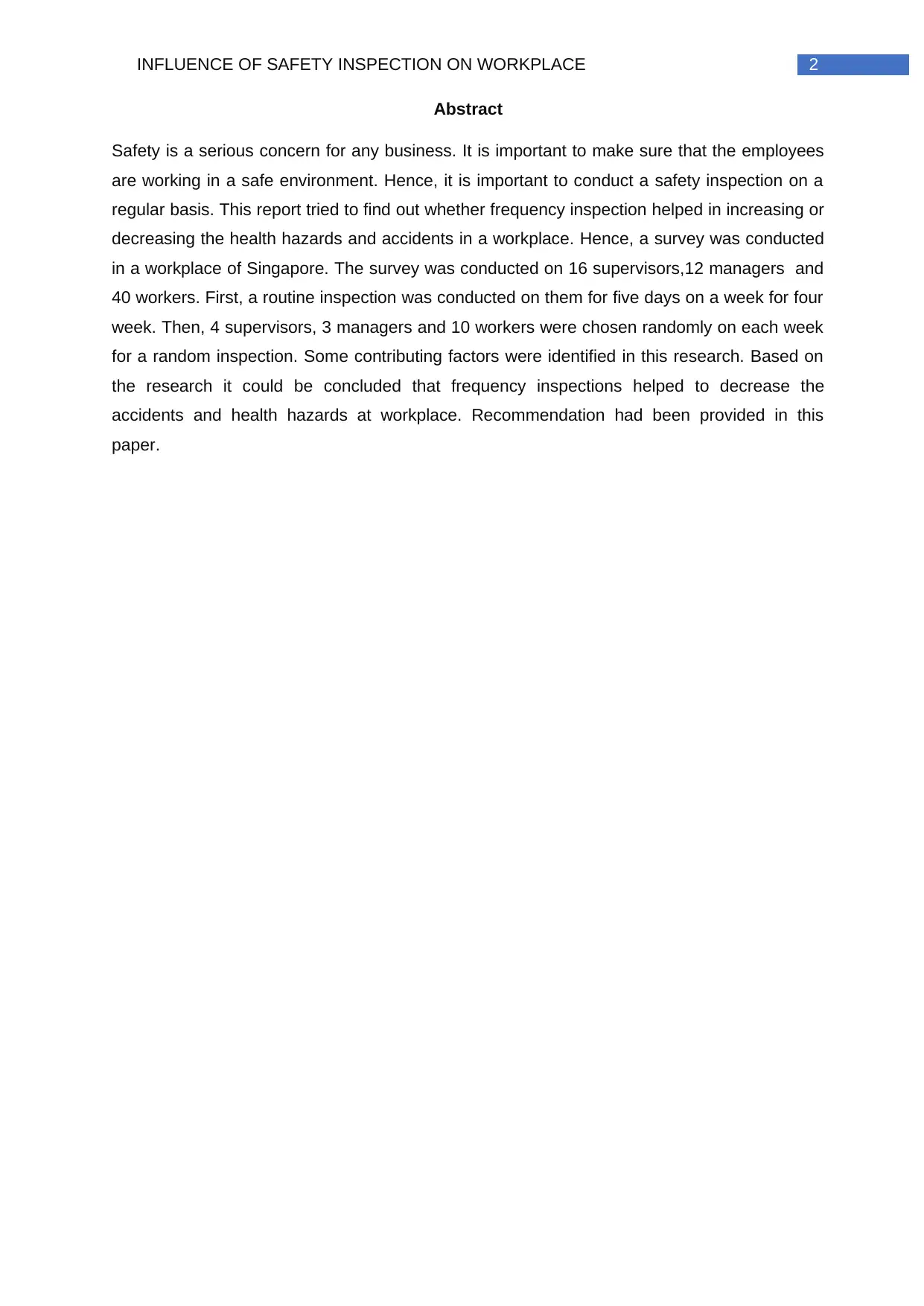
2INFLUENCE OF SAFETY INSPECTION ON WORKPLACE
Abstract
Safety is a serious concern for any business. It is important to make sure that the employees
are working in a safe environment. Hence, it is important to conduct a safety inspection on a
regular basis. This report tried to find out whether frequency inspection helped in increasing or
decreasing the health hazards and accidents in a workplace. Hence, a survey was conducted
in a workplace of Singapore. The survey was conducted on 16 supervisors,12 managers and
40 workers. First, a routine inspection was conducted on them for five days on a week for four
week. Then, 4 supervisors, 3 managers and 10 workers were chosen randomly on each week
for a random inspection. Some contributing factors were identified in this research. Based on
the research it could be concluded that frequency inspections helped to decrease the
accidents and health hazards at workplace. Recommendation had been provided in this
paper.
Abstract
Safety is a serious concern for any business. It is important to make sure that the employees
are working in a safe environment. Hence, it is important to conduct a safety inspection on a
regular basis. This report tried to find out whether frequency inspection helped in increasing or
decreasing the health hazards and accidents in a workplace. Hence, a survey was conducted
in a workplace of Singapore. The survey was conducted on 16 supervisors,12 managers and
40 workers. First, a routine inspection was conducted on them for five days on a week for four
week. Then, 4 supervisors, 3 managers and 10 workers were chosen randomly on each week
for a random inspection. Some contributing factors were identified in this research. Based on
the research it could be concluded that frequency inspections helped to decrease the
accidents and health hazards at workplace. Recommendation had been provided in this
paper.
⊘ This is a preview!⊘
Do you want full access?
Subscribe today to unlock all pages.

Trusted by 1+ million students worldwide
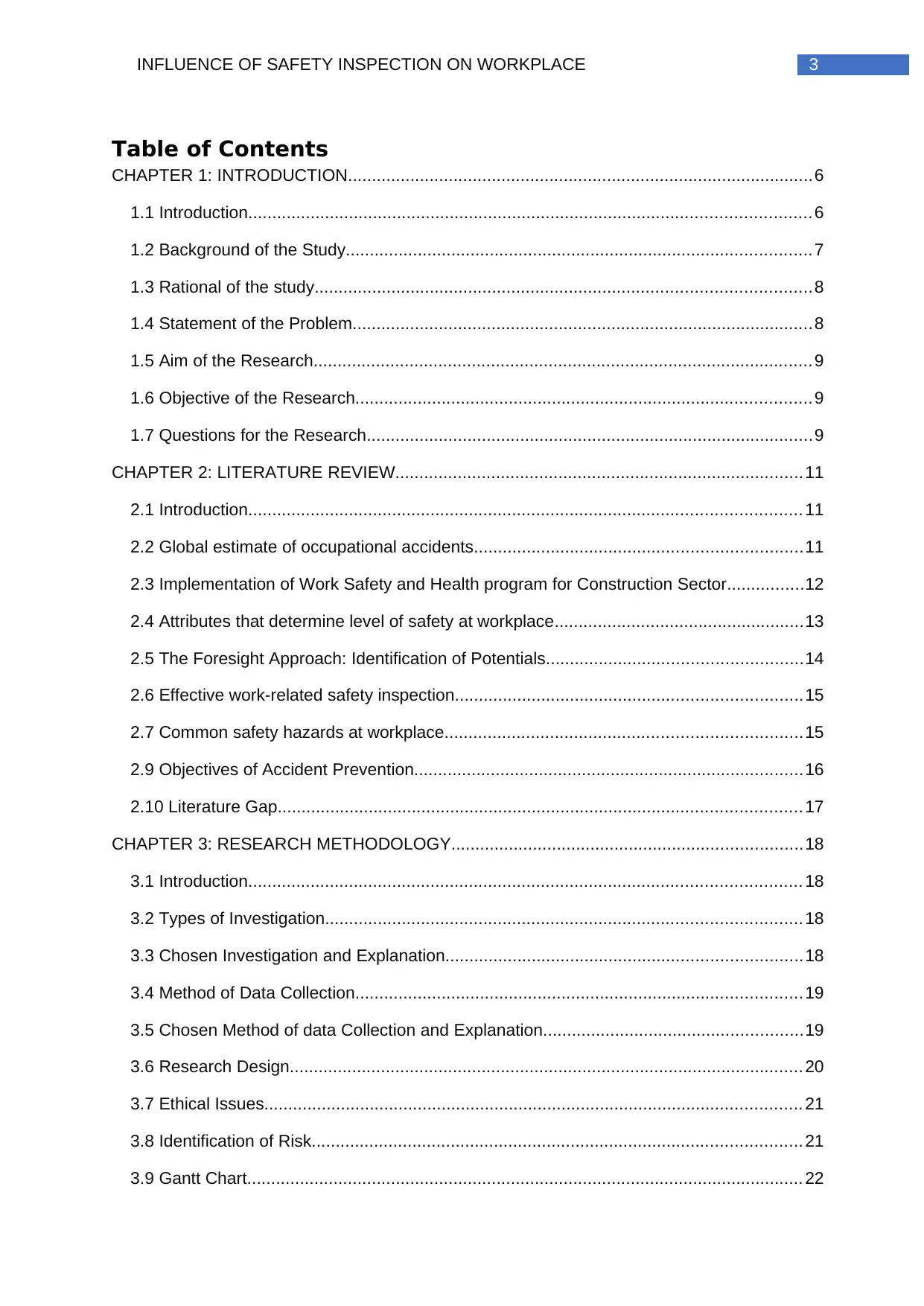
3INFLUENCE OF SAFETY INSPECTION ON WORKPLACE
Table of Contents
CHAPTER 1: INTRODUCTION.................................................................................................6
1.1 Introduction.....................................................................................................................6
1.2 Background of the Study.................................................................................................7
1.3 Rational of the study.......................................................................................................8
1.4 Statement of the Problem................................................................................................8
1.5 Aim of the Research........................................................................................................9
1.6 Objective of the Research...............................................................................................9
1.7 Questions for the Research.............................................................................................9
CHAPTER 2: LITERATURE REVIEW.....................................................................................11
2.1 Introduction................................................................................................................... 11
2.2 Global estimate of occupational accidents....................................................................11
2.3 Implementation of Work Safety and Health program for Construction Sector................12
2.4 Attributes that determine level of safety at workplace....................................................13
2.5 The Foresight Approach: Identification of Potentials.....................................................14
2.6 Effective work-related safety inspection........................................................................15
2.7 Common safety hazards at workplace..........................................................................15
2.9 Objectives of Accident Prevention.................................................................................16
2.10 Literature Gap............................................................................................................. 17
CHAPTER 3: RESEARCH METHODOLOGY.........................................................................18
3.1 Introduction................................................................................................................... 18
3.2 Types of Investigation...................................................................................................18
3.3 Chosen Investigation and Explanation..........................................................................18
3.4 Method of Data Collection.............................................................................................19
3.5 Chosen Method of data Collection and Explanation......................................................19
3.6 Research Design...........................................................................................................20
3.7 Ethical Issues................................................................................................................ 21
3.8 Identification of Risk......................................................................................................21
3.9 Gantt Chart.................................................................................................................... 22
Table of Contents
CHAPTER 1: INTRODUCTION.................................................................................................6
1.1 Introduction.....................................................................................................................6
1.2 Background of the Study.................................................................................................7
1.3 Rational of the study.......................................................................................................8
1.4 Statement of the Problem................................................................................................8
1.5 Aim of the Research........................................................................................................9
1.6 Objective of the Research...............................................................................................9
1.7 Questions for the Research.............................................................................................9
CHAPTER 2: LITERATURE REVIEW.....................................................................................11
2.1 Introduction................................................................................................................... 11
2.2 Global estimate of occupational accidents....................................................................11
2.3 Implementation of Work Safety and Health program for Construction Sector................12
2.4 Attributes that determine level of safety at workplace....................................................13
2.5 The Foresight Approach: Identification of Potentials.....................................................14
2.6 Effective work-related safety inspection........................................................................15
2.7 Common safety hazards at workplace..........................................................................15
2.9 Objectives of Accident Prevention.................................................................................16
2.10 Literature Gap............................................................................................................. 17
CHAPTER 3: RESEARCH METHODOLOGY.........................................................................18
3.1 Introduction................................................................................................................... 18
3.2 Types of Investigation...................................................................................................18
3.3 Chosen Investigation and Explanation..........................................................................18
3.4 Method of Data Collection.............................................................................................19
3.5 Chosen Method of data Collection and Explanation......................................................19
3.6 Research Design...........................................................................................................20
3.7 Ethical Issues................................................................................................................ 21
3.8 Identification of Risk......................................................................................................21
3.9 Gantt Chart.................................................................................................................... 22
Paraphrase This Document
Need a fresh take? Get an instant paraphrase of this document with our AI Paraphraser
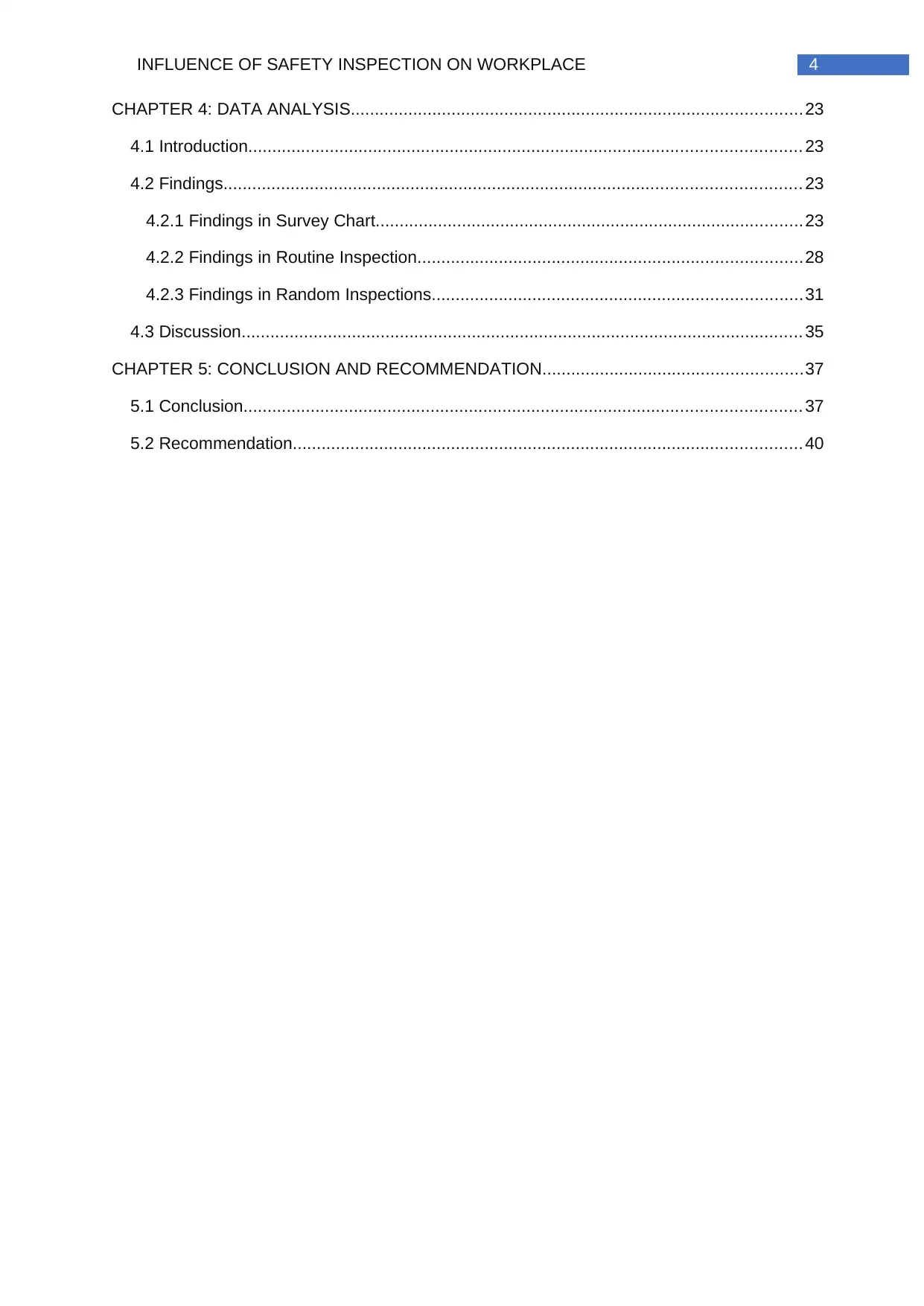
4INFLUENCE OF SAFETY INSPECTION ON WORKPLACE
CHAPTER 4: DATA ANALYSIS..............................................................................................23
4.1 Introduction................................................................................................................... 23
4.2 Findings........................................................................................................................ 23
4.2.1 Findings in Survey Chart.........................................................................................23
4.2.2 Findings in Routine Inspection................................................................................28
4.2.3 Findings in Random Inspections.............................................................................31
4.3 Discussion..................................................................................................................... 35
CHAPTER 5: CONCLUSION AND RECOMMENDATION......................................................37
5.1 Conclusion.................................................................................................................... 37
5.2 Recommendation..........................................................................................................40
CHAPTER 4: DATA ANALYSIS..............................................................................................23
4.1 Introduction................................................................................................................... 23
4.2 Findings........................................................................................................................ 23
4.2.1 Findings in Survey Chart.........................................................................................23
4.2.2 Findings in Routine Inspection................................................................................28
4.2.3 Findings in Random Inspections.............................................................................31
4.3 Discussion..................................................................................................................... 35
CHAPTER 5: CONCLUSION AND RECOMMENDATION......................................................37
5.1 Conclusion.................................................................................................................... 37
5.2 Recommendation..........................................................................................................40
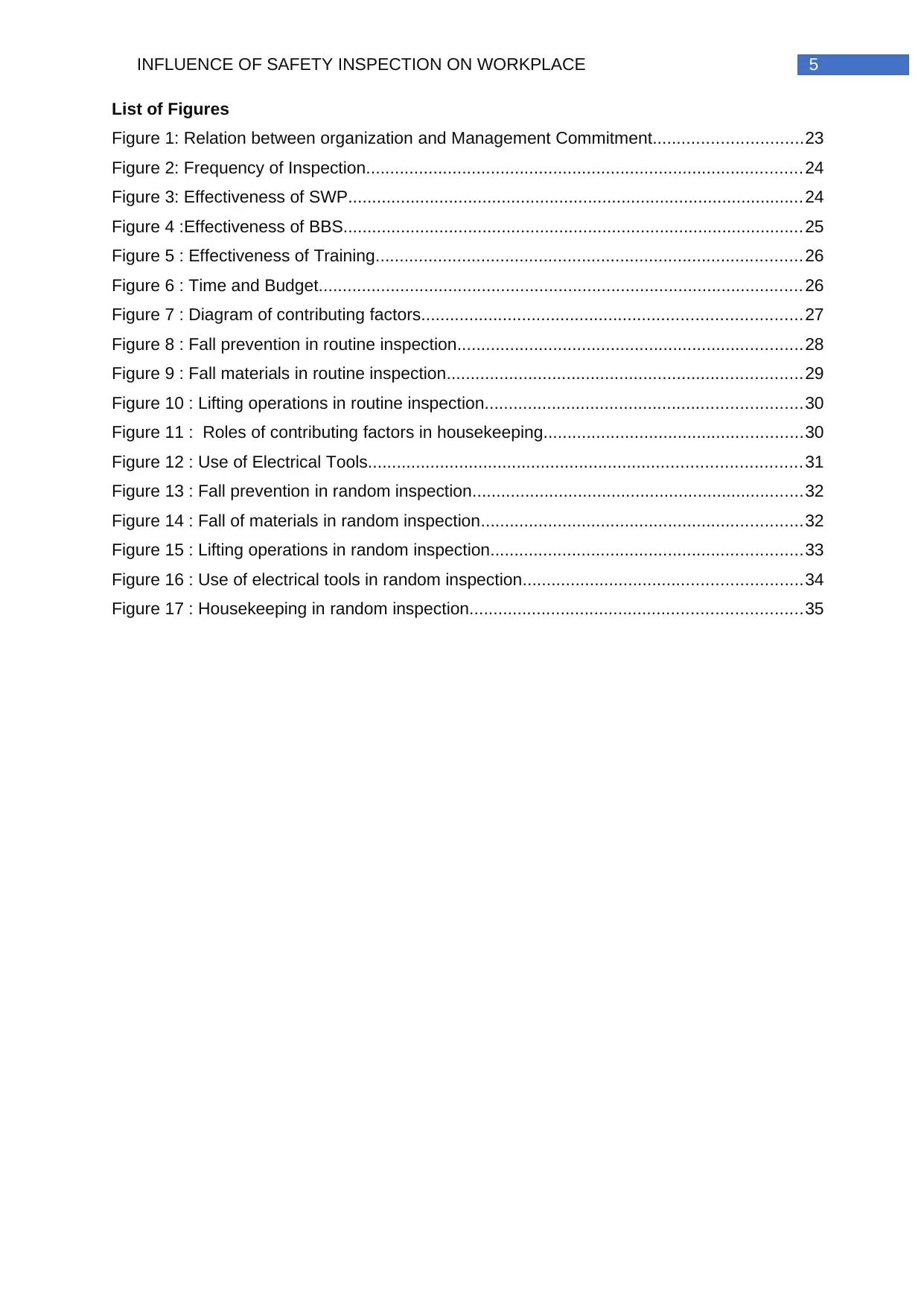
5INFLUENCE OF SAFETY INSPECTION ON WORKPLACE
List of Figures
Figure 1: Relation between organization and Management Commitment...............................23
Figure 2: Frequency of Inspection...........................................................................................24
Figure 3: Effectiveness of SWP...............................................................................................24
Figure 4 :Effectiveness of BBS................................................................................................25
Figure 5 : Effectiveness of Training.........................................................................................26
Figure 6 : Time and Budget.....................................................................................................26
Figure 7 : Diagram of contributing factors...............................................................................27
Figure 8 : Fall prevention in routine inspection........................................................................28
Figure 9 : Fall materials in routine inspection..........................................................................29
Figure 10 : Lifting operations in routine inspection..................................................................30
Figure 11 : Roles of contributing factors in housekeeping......................................................30
Figure 12 : Use of Electrical Tools..........................................................................................31
Figure 13 : Fall prevention in random inspection.....................................................................32
Figure 14 : Fall of materials in random inspection...................................................................32
Figure 15 : Lifting operations in random inspection.................................................................33
Figure 16 : Use of electrical tools in random inspection..........................................................34
Figure 17 : Housekeeping in random inspection.....................................................................35
List of Figures
Figure 1: Relation between organization and Management Commitment...............................23
Figure 2: Frequency of Inspection...........................................................................................24
Figure 3: Effectiveness of SWP...............................................................................................24
Figure 4 :Effectiveness of BBS................................................................................................25
Figure 5 : Effectiveness of Training.........................................................................................26
Figure 6 : Time and Budget.....................................................................................................26
Figure 7 : Diagram of contributing factors...............................................................................27
Figure 8 : Fall prevention in routine inspection........................................................................28
Figure 9 : Fall materials in routine inspection..........................................................................29
Figure 10 : Lifting operations in routine inspection..................................................................30
Figure 11 : Roles of contributing factors in housekeeping......................................................30
Figure 12 : Use of Electrical Tools..........................................................................................31
Figure 13 : Fall prevention in random inspection.....................................................................32
Figure 14 : Fall of materials in random inspection...................................................................32
Figure 15 : Lifting operations in random inspection.................................................................33
Figure 16 : Use of electrical tools in random inspection..........................................................34
Figure 17 : Housekeeping in random inspection.....................................................................35
⊘ This is a preview!⊘
Do you want full access?
Subscribe today to unlock all pages.

Trusted by 1+ million students worldwide
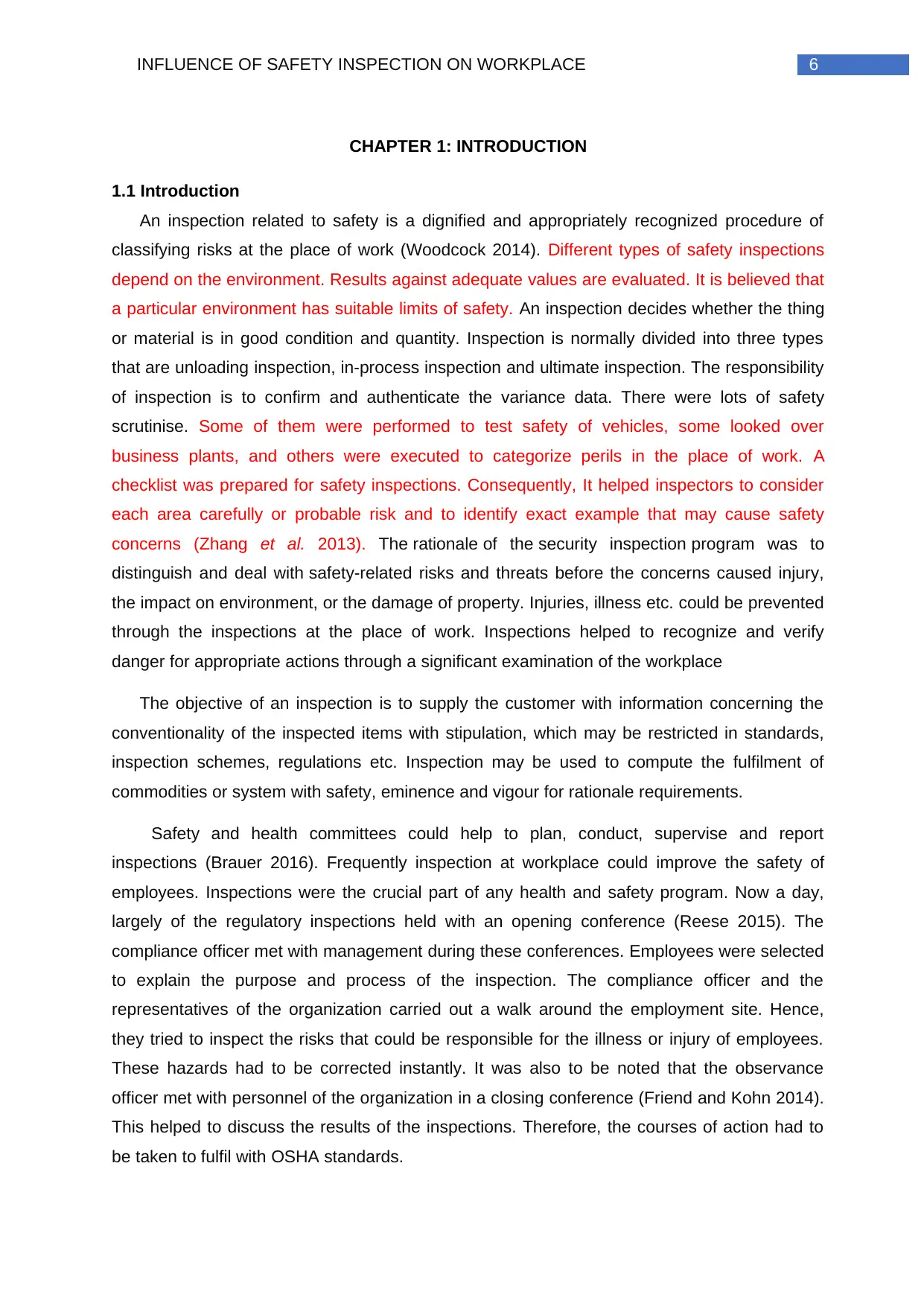
6INFLUENCE OF SAFETY INSPECTION ON WORKPLACE
CHAPTER 1: INTRODUCTION
1.1 Introduction
An inspection related to safety is a dignified and appropriately recognized procedure of
classifying risks at the place of work (Woodcock 2014). Different types of safety inspections
depend on the environment. Results against adequate values are evaluated. It is believed that
a particular environment has suitable limits of safety. An inspection decides whether the thing
or material is in good condition and quantity. Inspection is normally divided into three types
that are unloading inspection, in-process inspection and ultimate inspection. The responsibility
of inspection is to confirm and authenticate the variance data. There were lots of safety
scrutinise. Some of them were performed to test safety of vehicles, some looked over
business plants, and others were executed to categorize perils in the place of work. A
checklist was prepared for safety inspections. Consequently, It helped inspectors to consider
each area carefully or probable risk and to identify exact example that may cause safety
concerns (Zhang et al. 2013). The rationale of the security inspection program was to
distinguish and deal with safety-related risks and threats before the concerns caused injury,
the impact on environment, or the damage of property. Injuries, illness etc. could be prevented
through the inspections at the place of work. Inspections helped to recognize and verify
danger for appropriate actions through a significant examination of the workplace
The objective of an inspection is to supply the customer with information concerning the
conventionality of the inspected items with stipulation, which may be restricted in standards,
inspection schemes, regulations etc. Inspection may be used to compute the fulfilment of
commodities or system with safety, eminence and vigour for rationale requirements.
Safety and health committees could help to plan, conduct, supervise and report
inspections (Brauer 2016). Frequently inspection at workplace could improve the safety of
employees. Inspections were the crucial part of any health and safety program. Now a day,
largely of the regulatory inspections held with an opening conference (Reese 2015). The
compliance officer met with management during these conferences. Employees were selected
to explain the purpose and process of the inspection. The compliance officer and the
representatives of the organization carried out a walk around the employment site. Hence,
they tried to inspect the risks that could be responsible for the illness or injury of employees.
These hazards had to be corrected instantly. It was also to be noted that the observance
officer met with personnel of the organization in a closing conference (Friend and Kohn 2014).
This helped to discuss the results of the inspections. Therefore, the courses of action had to
be taken to fulfil with OSHA standards.
CHAPTER 1: INTRODUCTION
1.1 Introduction
An inspection related to safety is a dignified and appropriately recognized procedure of
classifying risks at the place of work (Woodcock 2014). Different types of safety inspections
depend on the environment. Results against adequate values are evaluated. It is believed that
a particular environment has suitable limits of safety. An inspection decides whether the thing
or material is in good condition and quantity. Inspection is normally divided into three types
that are unloading inspection, in-process inspection and ultimate inspection. The responsibility
of inspection is to confirm and authenticate the variance data. There were lots of safety
scrutinise. Some of them were performed to test safety of vehicles, some looked over
business plants, and others were executed to categorize perils in the place of work. A
checklist was prepared for safety inspections. Consequently, It helped inspectors to consider
each area carefully or probable risk and to identify exact example that may cause safety
concerns (Zhang et al. 2013). The rationale of the security inspection program was to
distinguish and deal with safety-related risks and threats before the concerns caused injury,
the impact on environment, or the damage of property. Injuries, illness etc. could be prevented
through the inspections at the place of work. Inspections helped to recognize and verify
danger for appropriate actions through a significant examination of the workplace
The objective of an inspection is to supply the customer with information concerning the
conventionality of the inspected items with stipulation, which may be restricted in standards,
inspection schemes, regulations etc. Inspection may be used to compute the fulfilment of
commodities or system with safety, eminence and vigour for rationale requirements.
Safety and health committees could help to plan, conduct, supervise and report
inspections (Brauer 2016). Frequently inspection at workplace could improve the safety of
employees. Inspections were the crucial part of any health and safety program. Now a day,
largely of the regulatory inspections held with an opening conference (Reese 2015). The
compliance officer met with management during these conferences. Employees were selected
to explain the purpose and process of the inspection. The compliance officer and the
representatives of the organization carried out a walk around the employment site. Hence,
they tried to inspect the risks that could be responsible for the illness or injury of employees.
These hazards had to be corrected instantly. It was also to be noted that the observance
officer met with personnel of the organization in a closing conference (Friend and Kohn 2014).
This helped to discuss the results of the inspections. Therefore, the courses of action had to
be taken to fulfil with OSHA standards.
Paraphrase This Document
Need a fresh take? Get an instant paraphrase of this document with our AI Paraphraser
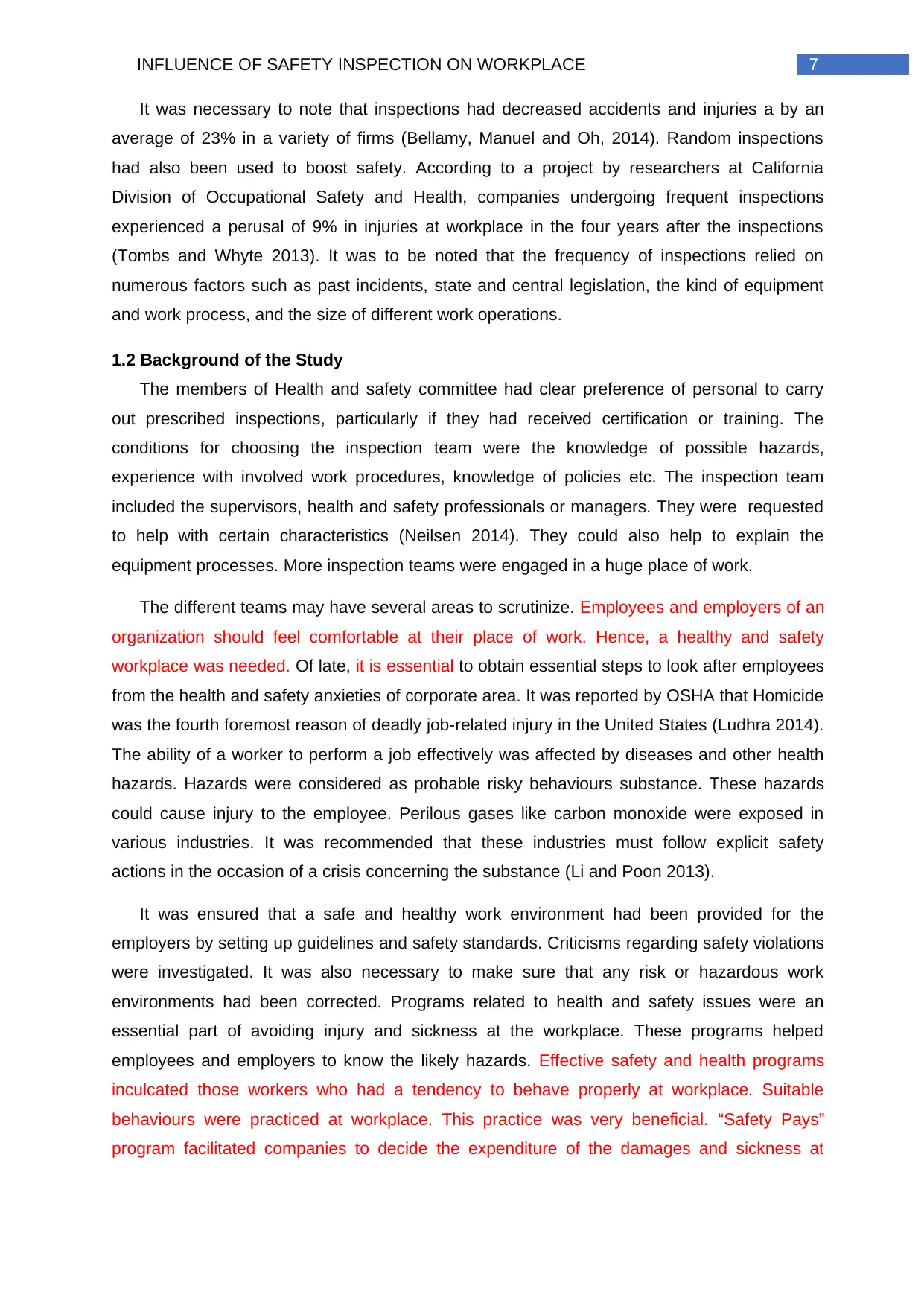
7INFLUENCE OF SAFETY INSPECTION ON WORKPLACE
It was necessary to note that inspections had decreased accidents and injuries a by an
average of 23% in a variety of firms (Bellamy, Manuel and Oh, 2014). Random inspections
had also been used to boost safety. According to a project by researchers at California
Division of Occupational Safety and Health, companies undergoing frequent inspections
experienced a perusal of 9% in injuries at workplace in the four years after the inspections
(Tombs and Whyte 2013). It was to be noted that the frequency of inspections relied on
numerous factors such as past incidents, state and central legislation, the kind of equipment
and work process, and the size of different work operations.
1.2 Background of the Study
The members of Health and safety committee had clear preference of personal to carry
out prescribed inspections, particularly if they had received certification or training. The
conditions for choosing the inspection team were the knowledge of possible hazards,
experience with involved work procedures, knowledge of policies etc. The inspection team
included the supervisors, health and safety professionals or managers. They were requested
to help with certain characteristics (Neilsen 2014). They could also help to explain the
equipment processes. More inspection teams were engaged in a huge place of work.
The different teams may have several areas to scrutinize. Employees and employers of an
organization should feel comfortable at their place of work. Hence, a healthy and safety
workplace was needed. Of late, it is essential to obtain essential steps to look after employees
from the health and safety anxieties of corporate area. It was reported by OSHA that Homicide
was the fourth foremost reason of deadly job-related injury in the United States (Ludhra 2014).
The ability of a worker to perform a job effectively was affected by diseases and other health
hazards. Hazards were considered as probable risky behaviours substance. These hazards
could cause injury to the employee. Perilous gases like carbon monoxide were exposed in
various industries. It was recommended that these industries must follow explicit safety
actions in the occasion of a crisis concerning the substance (Li and Poon 2013).
It was ensured that a safe and healthy work environment had been provided for the
employers by setting up guidelines and safety standards. Criticisms regarding safety violations
were investigated. It was also necessary to make sure that any risk or hazardous work
environments had been corrected. Programs related to health and safety issues were an
essential part of avoiding injury and sickness at the workplace. These programs helped
employees and employers to know the likely hazards. Effective safety and health programs
inculcated those workers who had a tendency to behave properly at workplace. Suitable
behaviours were practiced at workplace. This practice was very beneficial. “Safety Pays”
program facilitated companies to decide the expenditure of the damages and sickness at
It was necessary to note that inspections had decreased accidents and injuries a by an
average of 23% in a variety of firms (Bellamy, Manuel and Oh, 2014). Random inspections
had also been used to boost safety. According to a project by researchers at California
Division of Occupational Safety and Health, companies undergoing frequent inspections
experienced a perusal of 9% in injuries at workplace in the four years after the inspections
(Tombs and Whyte 2013). It was to be noted that the frequency of inspections relied on
numerous factors such as past incidents, state and central legislation, the kind of equipment
and work process, and the size of different work operations.
1.2 Background of the Study
The members of Health and safety committee had clear preference of personal to carry
out prescribed inspections, particularly if they had received certification or training. The
conditions for choosing the inspection team were the knowledge of possible hazards,
experience with involved work procedures, knowledge of policies etc. The inspection team
included the supervisors, health and safety professionals or managers. They were requested
to help with certain characteristics (Neilsen 2014). They could also help to explain the
equipment processes. More inspection teams were engaged in a huge place of work.
The different teams may have several areas to scrutinize. Employees and employers of an
organization should feel comfortable at their place of work. Hence, a healthy and safety
workplace was needed. Of late, it is essential to obtain essential steps to look after employees
from the health and safety anxieties of corporate area. It was reported by OSHA that Homicide
was the fourth foremost reason of deadly job-related injury in the United States (Ludhra 2014).
The ability of a worker to perform a job effectively was affected by diseases and other health
hazards. Hazards were considered as probable risky behaviours substance. These hazards
could cause injury to the employee. Perilous gases like carbon monoxide were exposed in
various industries. It was recommended that these industries must follow explicit safety
actions in the occasion of a crisis concerning the substance (Li and Poon 2013).
It was ensured that a safe and healthy work environment had been provided for the
employers by setting up guidelines and safety standards. Criticisms regarding safety violations
were investigated. It was also necessary to make sure that any risk or hazardous work
environments had been corrected. Programs related to health and safety issues were an
essential part of avoiding injury and sickness at the workplace. These programs helped
employees and employers to know the likely hazards. Effective safety and health programs
inculcated those workers who had a tendency to behave properly at workplace. Suitable
behaviours were practiced at workplace. This practice was very beneficial. “Safety Pays”
program facilitated companies to decide the expenditure of the damages and sickness at
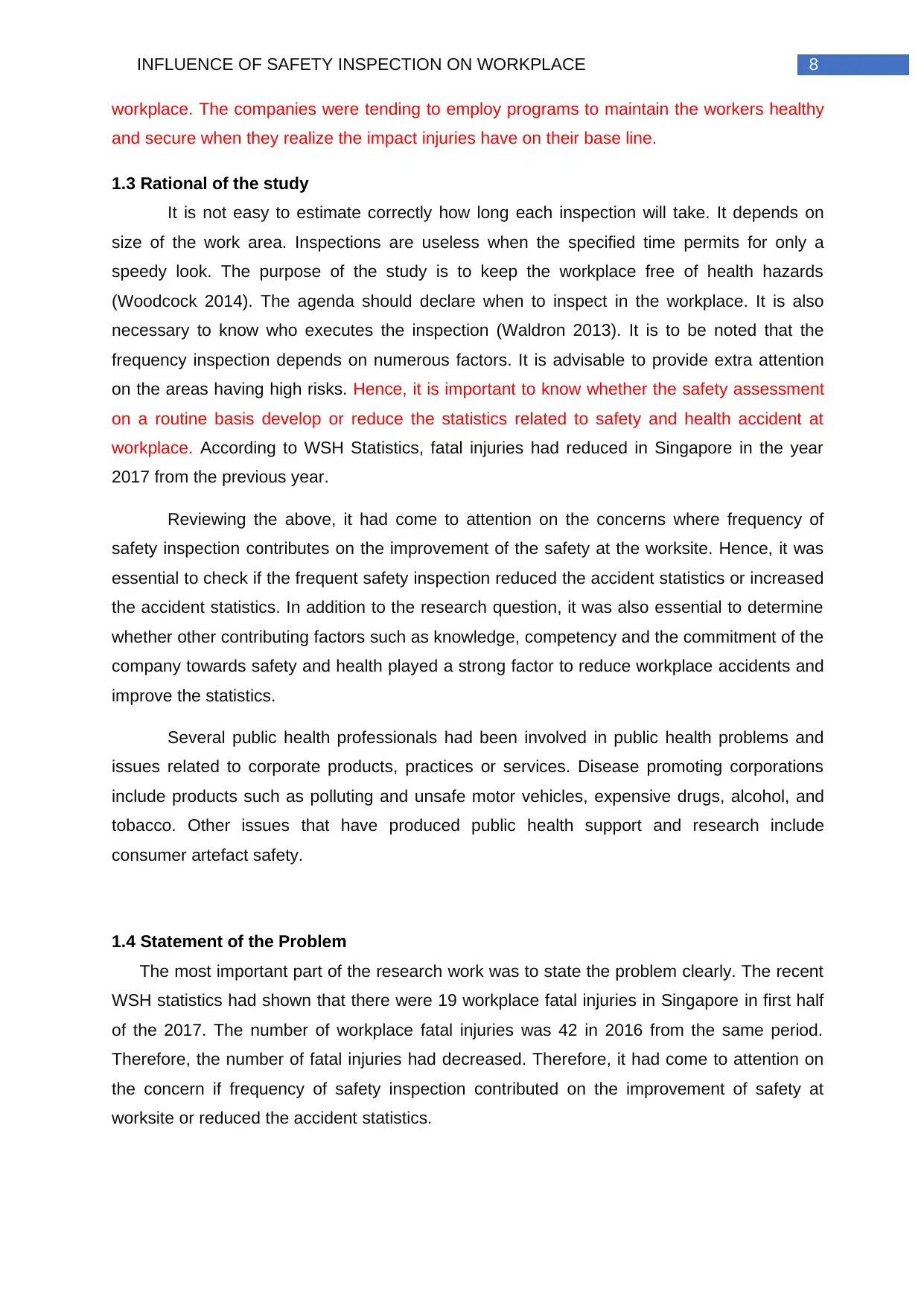
8INFLUENCE OF SAFETY INSPECTION ON WORKPLACE
workplace. The companies were tending to employ programs to maintain the workers healthy
and secure when they realize the impact injuries have on their base line.
1.3 Rational of the study
It is not easy to estimate correctly how long each inspection will take. It depends on
size of the work area. Inspections are useless when the specified time permits for only a
speedy look. The purpose of the study is to keep the workplace free of health hazards
(Woodcock 2014). The agenda should declare when to inspect in the workplace. It is also
necessary to know who executes the inspection (Waldron 2013). It is to be noted that the
frequency inspection depends on numerous factors. It is advisable to provide extra attention
on the areas having high risks. Hence, it is important to know whether the safety assessment
on a routine basis develop or reduce the statistics related to safety and health accident at
workplace. According to WSH Statistics, fatal injuries had reduced in Singapore in the year
2017 from the previous year.
Reviewing the above, it had come to attention on the concerns where frequency of
safety inspection contributes on the improvement of the safety at the worksite. Hence, it was
essential to check if the frequent safety inspection reduced the accident statistics or increased
the accident statistics. In addition to the research question, it was also essential to determine
whether other contributing factors such as knowledge, competency and the commitment of the
company towards safety and health played a strong factor to reduce workplace accidents and
improve the statistics.
Several public health professionals had been involved in public health problems and
issues related to corporate products, practices or services. Disease promoting corporations
include products such as polluting and unsafe motor vehicles, expensive drugs, alcohol, and
tobacco. Other issues that have produced public health support and research include
consumer artefact safety.
1.4 Statement of the Problem
The most important part of the research work was to state the problem clearly. The recent
WSH statistics had shown that there were 19 workplace fatal injuries in Singapore in first half
of the 2017. The number of workplace fatal injuries was 42 in 2016 from the same period.
Therefore, the number of fatal injuries had decreased. Therefore, it had come to attention on
the concern if frequency of safety inspection contributed on the improvement of safety at
worksite or reduced the accident statistics.
workplace. The companies were tending to employ programs to maintain the workers healthy
and secure when they realize the impact injuries have on their base line.
1.3 Rational of the study
It is not easy to estimate correctly how long each inspection will take. It depends on
size of the work area. Inspections are useless when the specified time permits for only a
speedy look. The purpose of the study is to keep the workplace free of health hazards
(Woodcock 2014). The agenda should declare when to inspect in the workplace. It is also
necessary to know who executes the inspection (Waldron 2013). It is to be noted that the
frequency inspection depends on numerous factors. It is advisable to provide extra attention
on the areas having high risks. Hence, it is important to know whether the safety assessment
on a routine basis develop or reduce the statistics related to safety and health accident at
workplace. According to WSH Statistics, fatal injuries had reduced in Singapore in the year
2017 from the previous year.
Reviewing the above, it had come to attention on the concerns where frequency of
safety inspection contributes on the improvement of the safety at the worksite. Hence, it was
essential to check if the frequent safety inspection reduced the accident statistics or increased
the accident statistics. In addition to the research question, it was also essential to determine
whether other contributing factors such as knowledge, competency and the commitment of the
company towards safety and health played a strong factor to reduce workplace accidents and
improve the statistics.
Several public health professionals had been involved in public health problems and
issues related to corporate products, practices or services. Disease promoting corporations
include products such as polluting and unsafe motor vehicles, expensive drugs, alcohol, and
tobacco. Other issues that have produced public health support and research include
consumer artefact safety.
1.4 Statement of the Problem
The most important part of the research work was to state the problem clearly. The recent
WSH statistics had shown that there were 19 workplace fatal injuries in Singapore in first half
of the 2017. The number of workplace fatal injuries was 42 in 2016 from the same period.
Therefore, the number of fatal injuries had decreased. Therefore, it had come to attention on
the concern if frequency of safety inspection contributed on the improvement of safety at
worksite or reduced the accident statistics.
⊘ This is a preview!⊘
Do you want full access?
Subscribe today to unlock all pages.

Trusted by 1+ million students worldwide
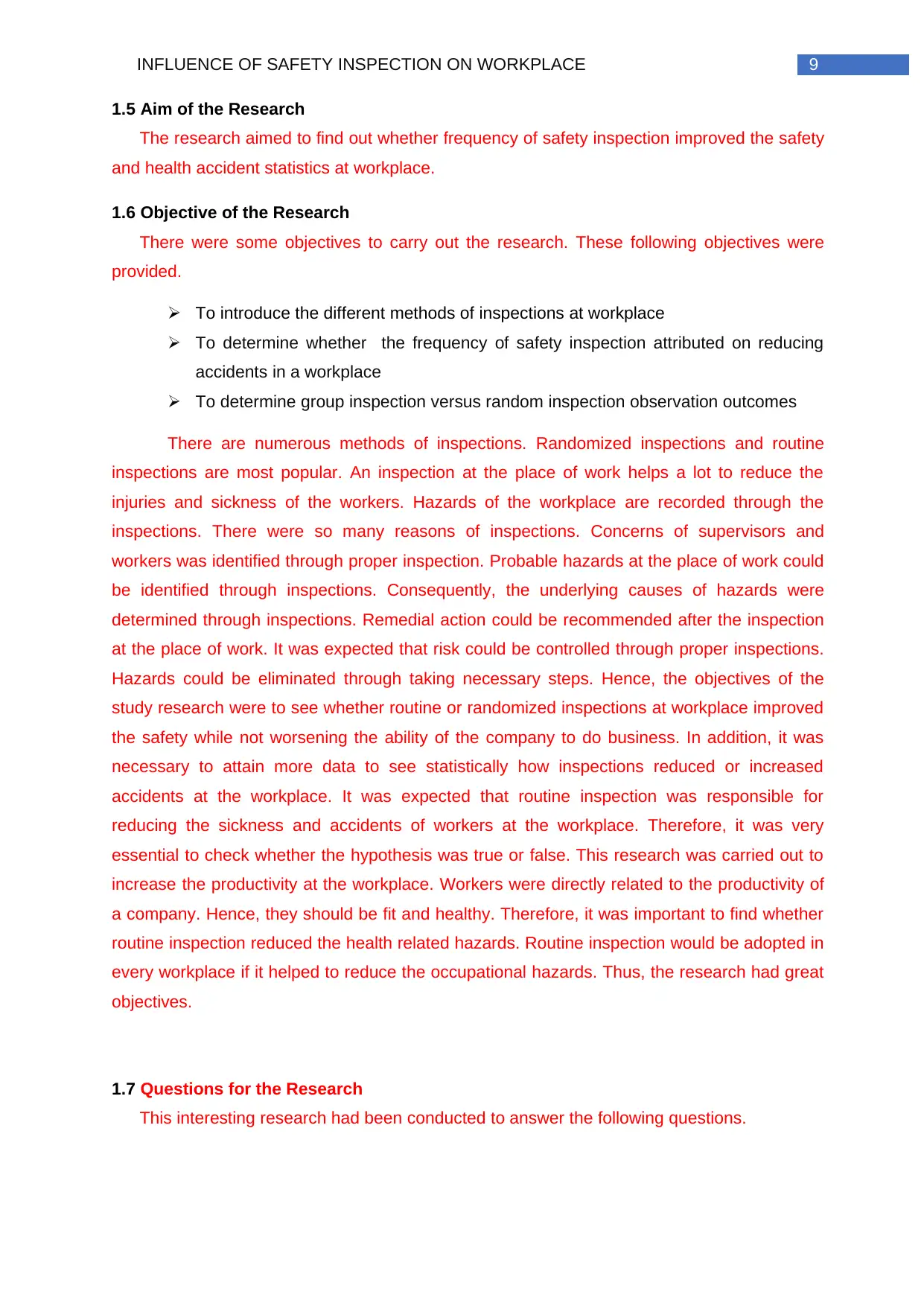
9INFLUENCE OF SAFETY INSPECTION ON WORKPLACE
1.5 Aim of the Research
The research aimed to find out whether frequency of safety inspection improved the safety
and health accident statistics at workplace.
1.6 Objective of the Research
There were some objectives to carry out the research. These following objectives were
provided.
To introduce the different methods of inspections at workplace
To determine whether the frequency of safety inspection attributed on reducing
accidents in a workplace
To determine group inspection versus random inspection observation outcomes
There are numerous methods of inspections. Randomized inspections and routine
inspections are most popular. An inspection at the place of work helps a lot to reduce the
injuries and sickness of the workers. Hazards of the workplace are recorded through the
inspections. There were so many reasons of inspections. Concerns of supervisors and
workers was identified through proper inspection. Probable hazards at the place of work could
be identified through inspections. Consequently, the underlying causes of hazards were
determined through inspections. Remedial action could be recommended after the inspection
at the place of work. It was expected that risk could be controlled through proper inspections.
Hazards could be eliminated through taking necessary steps. Hence, the objectives of the
study research were to see whether routine or randomized inspections at workplace improved
the safety while not worsening the ability of the company to do business. In addition, it was
necessary to attain more data to see statistically how inspections reduced or increased
accidents at the workplace. It was expected that routine inspection was responsible for
reducing the sickness and accidents of workers at the workplace. Therefore, it was very
essential to check whether the hypothesis was true or false. This research was carried out to
increase the productivity at the workplace. Workers were directly related to the productivity of
a company. Hence, they should be fit and healthy. Therefore, it was important to find whether
routine inspection reduced the health related hazards. Routine inspection would be adopted in
every workplace if it helped to reduce the occupational hazards. Thus, the research had great
objectives.
1.7 Questions for the Research
This interesting research had been conducted to answer the following questions.
1.5 Aim of the Research
The research aimed to find out whether frequency of safety inspection improved the safety
and health accident statistics at workplace.
1.6 Objective of the Research
There were some objectives to carry out the research. These following objectives were
provided.
To introduce the different methods of inspections at workplace
To determine whether the frequency of safety inspection attributed on reducing
accidents in a workplace
To determine group inspection versus random inspection observation outcomes
There are numerous methods of inspections. Randomized inspections and routine
inspections are most popular. An inspection at the place of work helps a lot to reduce the
injuries and sickness of the workers. Hazards of the workplace are recorded through the
inspections. There were so many reasons of inspections. Concerns of supervisors and
workers was identified through proper inspection. Probable hazards at the place of work could
be identified through inspections. Consequently, the underlying causes of hazards were
determined through inspections. Remedial action could be recommended after the inspection
at the place of work. It was expected that risk could be controlled through proper inspections.
Hazards could be eliminated through taking necessary steps. Hence, the objectives of the
study research were to see whether routine or randomized inspections at workplace improved
the safety while not worsening the ability of the company to do business. In addition, it was
necessary to attain more data to see statistically how inspections reduced or increased
accidents at the workplace. It was expected that routine inspection was responsible for
reducing the sickness and accidents of workers at the workplace. Therefore, it was very
essential to check whether the hypothesis was true or false. This research was carried out to
increase the productivity at the workplace. Workers were directly related to the productivity of
a company. Hence, they should be fit and healthy. Therefore, it was important to find whether
routine inspection reduced the health related hazards. Routine inspection would be adopted in
every workplace if it helped to reduce the occupational hazards. Thus, the research had great
objectives.
1.7 Questions for the Research
This interesting research had been conducted to answer the following questions.
Paraphrase This Document
Need a fresh take? Get an instant paraphrase of this document with our AI Paraphraser
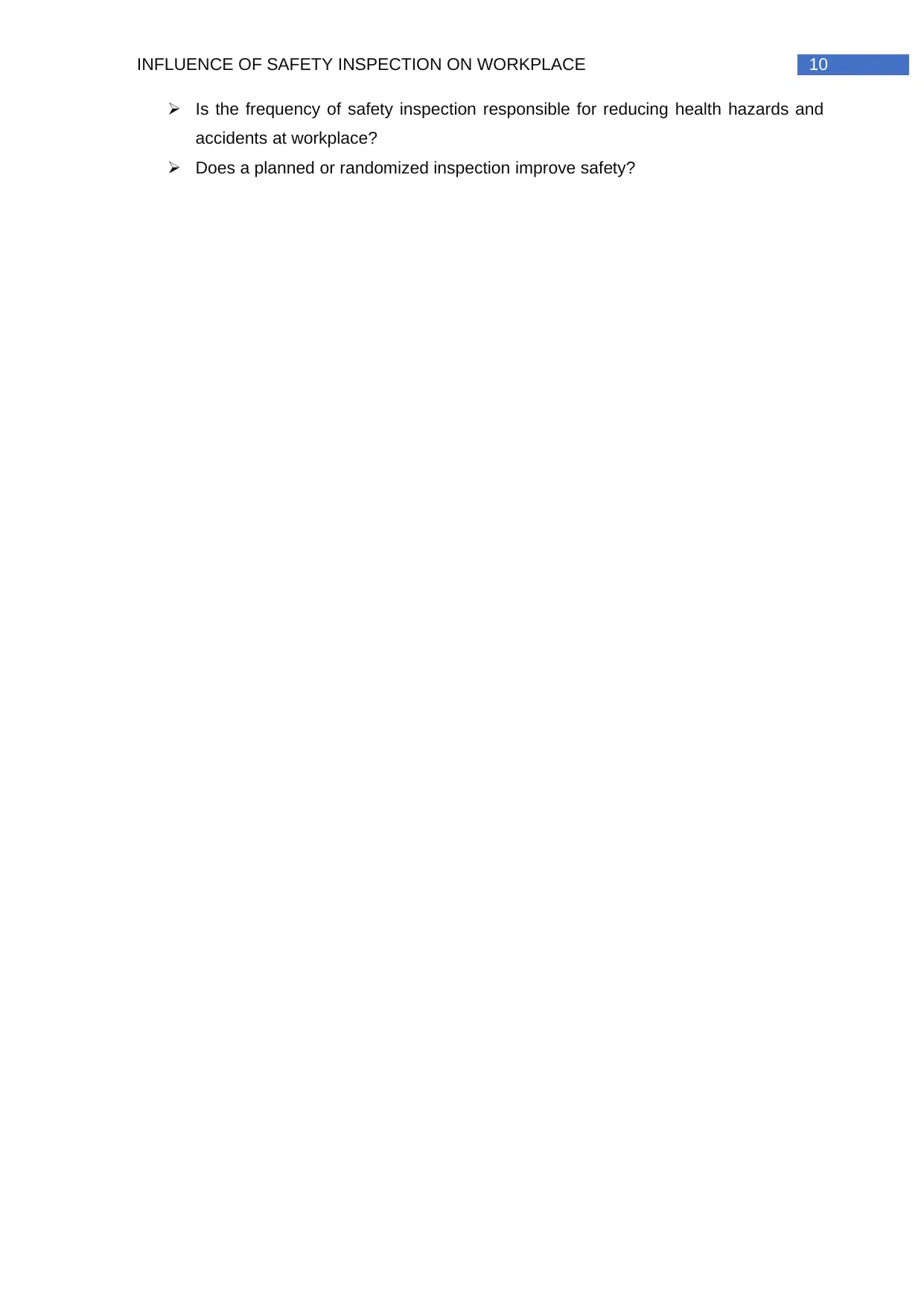
10INFLUENCE OF SAFETY INSPECTION ON WORKPLACE
Is the frequency of safety inspection responsible for reducing health hazards and
accidents at workplace?
Does a planned or randomized inspection improve safety?
Is the frequency of safety inspection responsible for reducing health hazards and
accidents at workplace?
Does a planned or randomized inspection improve safety?
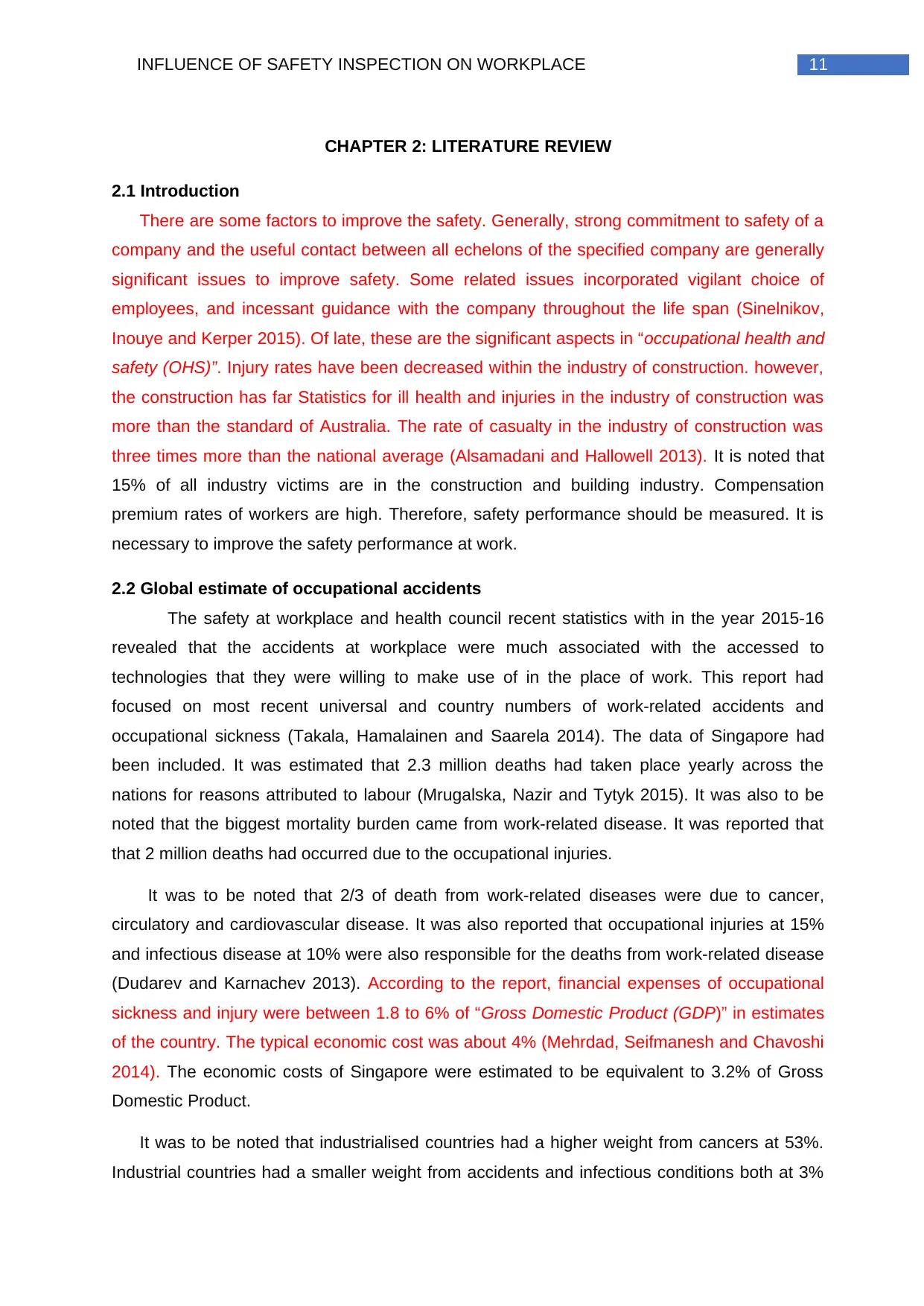
11INFLUENCE OF SAFETY INSPECTION ON WORKPLACE
CHAPTER 2: LITERATURE REVIEW
2.1 Introduction
There are some factors to improve the safety. Generally, strong commitment to safety of a
company and the useful contact between all echelons of the specified company are generally
significant issues to improve safety. Some related issues incorporated vigilant choice of
employees, and incessant guidance with the company throughout the life span (Sinelnikov,
Inouye and Kerper 2015). Of late, these are the significant aspects in “occupational health and
safety (OHS)”. Injury rates have been decreased within the industry of construction. however,
the construction has far Statistics for ill health and injuries in the industry of construction was
more than the standard of Australia. The rate of casualty in the industry of construction was
three times more than the national average (Alsamadani and Hallowell 2013). It is noted that
15% of all industry victims are in the construction and building industry. Compensation
premium rates of workers are high. Therefore, safety performance should be measured. It is
necessary to improve the safety performance at work.
2.2 Global estimate of occupational accidents
The safety at workplace and health council recent statistics with in the year 2015-16
revealed that the accidents at workplace were much associated with the accessed to
technologies that they were willing to make use of in the place of work. This report had
focused on most recent universal and country numbers of work-related accidents and
occupational sickness (Takala, Hamalainen and Saarela 2014). The data of Singapore had
been included. It was estimated that 2.3 million deaths had taken place yearly across the
nations for reasons attributed to labour (Mrugalska, Nazir and Tytyk 2015). It was also to be
noted that the biggest mortality burden came from work-related disease. It was reported that
that 2 million deaths had occurred due to the occupational injuries.
It was to be noted that 2/3 of death from work-related diseases were due to cancer,
circulatory and cardiovascular disease. It was also reported that occupational injuries at 15%
and infectious disease at 10% were also responsible for the deaths from work-related disease
(Dudarev and Karnachev 2013). According to the report, financial expenses of occupational
sickness and injury were between 1.8 to 6% of “Gross Domestic Product (GDP)” in estimates
of the country. The typical economic cost was about 4% (Mehrdad, Seifmanesh and Chavoshi
2014). The economic costs of Singapore were estimated to be equivalent to 3.2% of Gross
Domestic Product.
It was to be noted that industrialised countries had a higher weight from cancers at 53%.
Industrial countries had a smaller weight from accidents and infectious conditions both at 3%
CHAPTER 2: LITERATURE REVIEW
2.1 Introduction
There are some factors to improve the safety. Generally, strong commitment to safety of a
company and the useful contact between all echelons of the specified company are generally
significant issues to improve safety. Some related issues incorporated vigilant choice of
employees, and incessant guidance with the company throughout the life span (Sinelnikov,
Inouye and Kerper 2015). Of late, these are the significant aspects in “occupational health and
safety (OHS)”. Injury rates have been decreased within the industry of construction. however,
the construction has far Statistics for ill health and injuries in the industry of construction was
more than the standard of Australia. The rate of casualty in the industry of construction was
three times more than the national average (Alsamadani and Hallowell 2013). It is noted that
15% of all industry victims are in the construction and building industry. Compensation
premium rates of workers are high. Therefore, safety performance should be measured. It is
necessary to improve the safety performance at work.
2.2 Global estimate of occupational accidents
The safety at workplace and health council recent statistics with in the year 2015-16
revealed that the accidents at workplace were much associated with the accessed to
technologies that they were willing to make use of in the place of work. This report had
focused on most recent universal and country numbers of work-related accidents and
occupational sickness (Takala, Hamalainen and Saarela 2014). The data of Singapore had
been included. It was estimated that 2.3 million deaths had taken place yearly across the
nations for reasons attributed to labour (Mrugalska, Nazir and Tytyk 2015). It was also to be
noted that the biggest mortality burden came from work-related disease. It was reported that
that 2 million deaths had occurred due to the occupational injuries.
It was to be noted that 2/3 of death from work-related diseases were due to cancer,
circulatory and cardiovascular disease. It was also reported that occupational injuries at 15%
and infectious disease at 10% were also responsible for the deaths from work-related disease
(Dudarev and Karnachev 2013). According to the report, financial expenses of occupational
sickness and injury were between 1.8 to 6% of “Gross Domestic Product (GDP)” in estimates
of the country. The typical economic cost was about 4% (Mehrdad, Seifmanesh and Chavoshi
2014). The economic costs of Singapore were estimated to be equivalent to 3.2% of Gross
Domestic Product.
It was to be noted that industrialised countries had a higher weight from cancers at 53%.
Industrial countries had a smaller weight from accidents and infectious conditions both at 3%
⊘ This is a preview!⊘
Do you want full access?
Subscribe today to unlock all pages.

Trusted by 1+ million students worldwide
1 out of 54
Related Documents
Your All-in-One AI-Powered Toolkit for Academic Success.
+13062052269
info@desklib.com
Available 24*7 on WhatsApp / Email
![[object Object]](/_next/static/media/star-bottom.7253800d.svg)
Unlock your academic potential
Copyright © 2020–2025 A2Z Services. All Rights Reserved. Developed and managed by ZUCOL.




